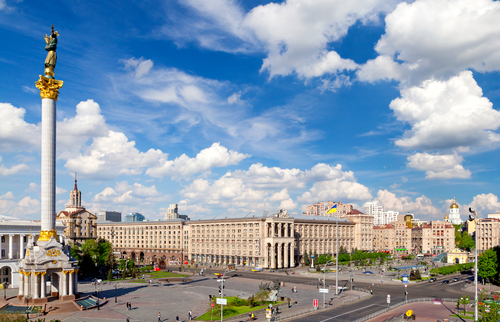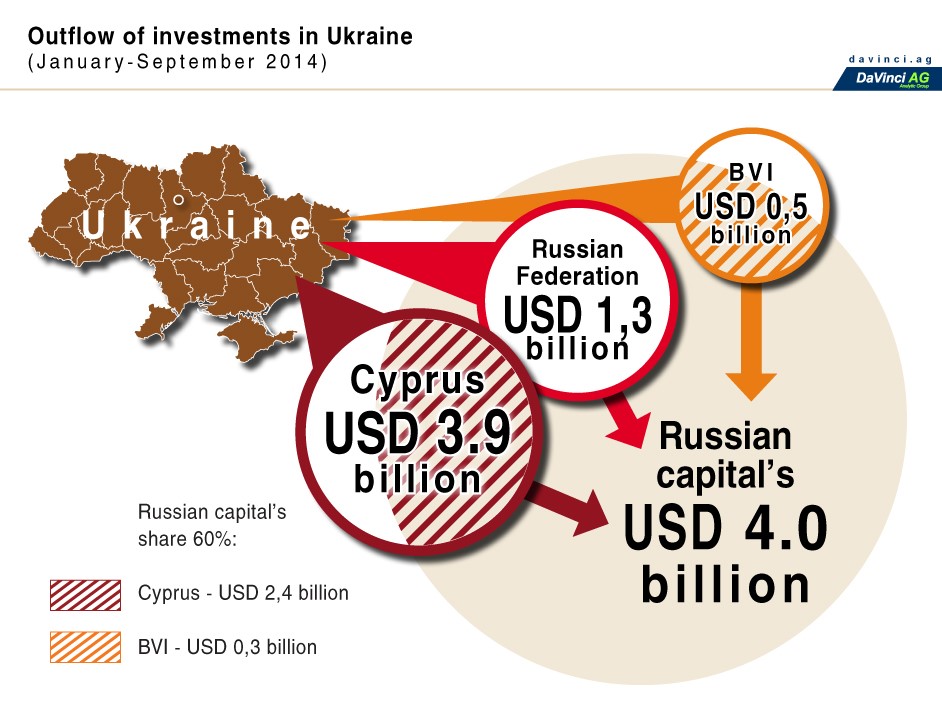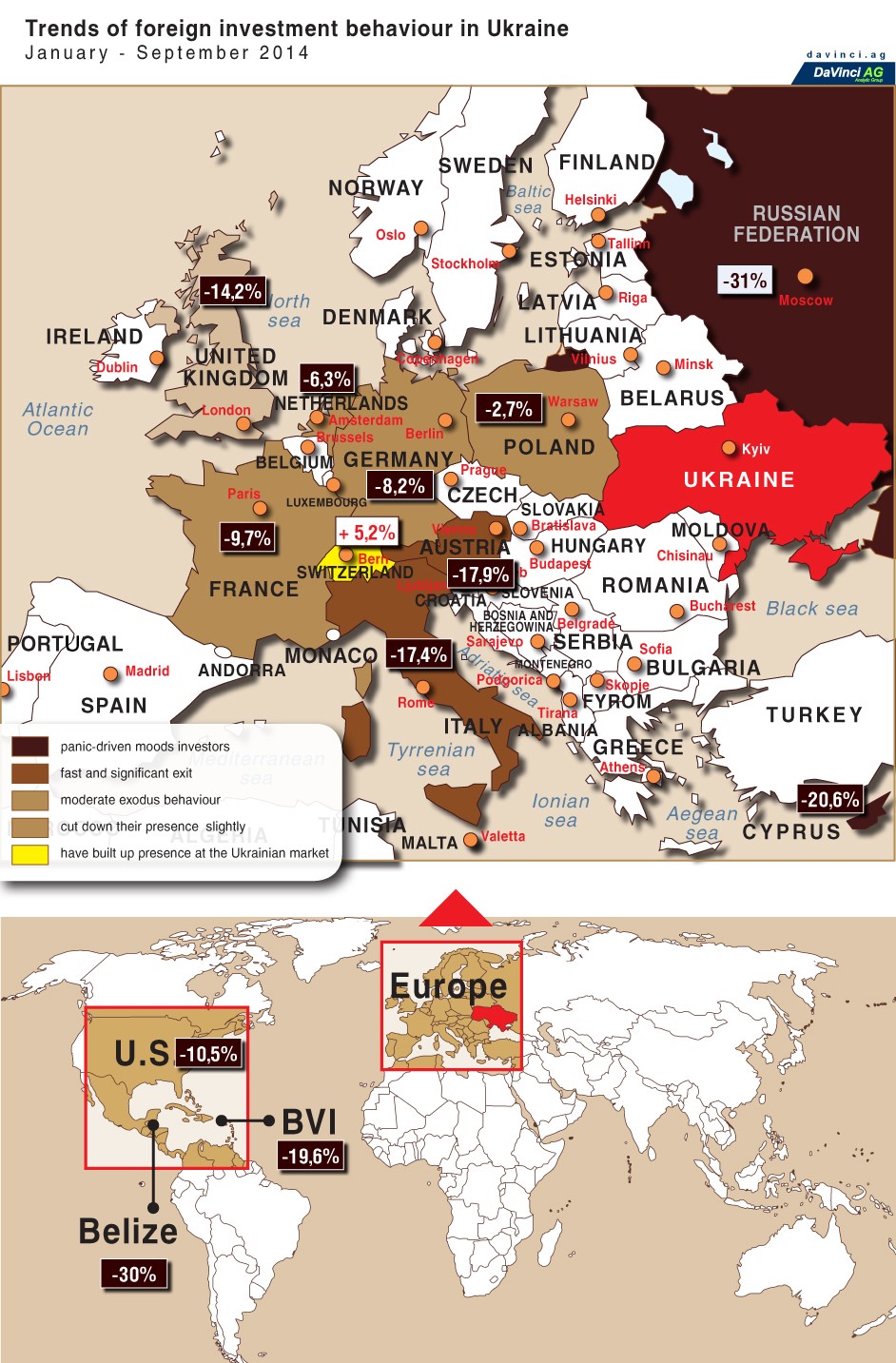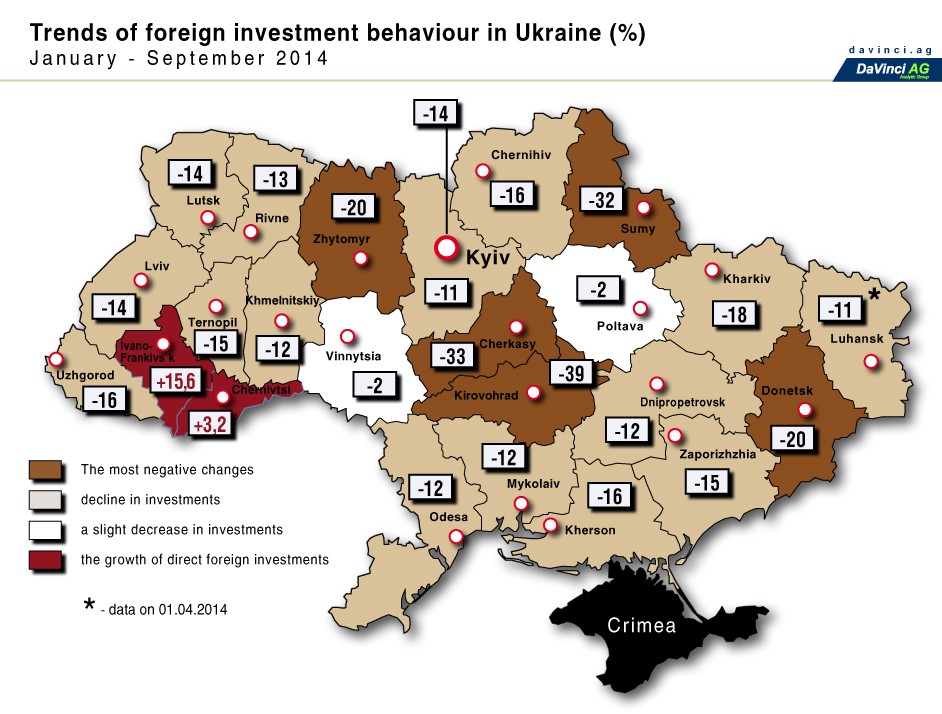Foreign Direct Investment in Troubled Ukraine

Please note that we are not authorised to provide any investment advice. The content on this page is for information purposes only.
Domestic policy crisis, Crimea’s loss, war in the south-east of Ukraine, and Russia’s aggression amid the lack of any thorough economic reforms and a single decision making unit built-up in Kyiv have triggered Ukraine’s loss of direct foreign investment in the first nine months of 2014. Over this period, Ukraine has lost 16.6% of all direct foreign investments raised to the economy from the date of independence. It accounts for USD 9.6 billion in monetary terms.
Domestic policy crisis, Crimea’s loss, war in the south-east of Ukraine, and Russia’s aggression amid the lack of any thorough economic reforms and a single decision making unit built-up in Kyiv have triggered Ukraine’s loss of direct foreign investment in the first nine months of 2014. Over this period, Ukraine has lost 16.6% of all direct foreign investments raised to the economy from the date of independence. It accounts for USD 9.6 billion in monetary terms. According to our estimations, at year-end, Ukraine will have the foreign investment quote equivalent to mid-2011. At the same time, we believe that the state has already passed the peak of investment losses. This owes to both attitude of key western investors towards Ukraine’s economy and Russia’s viewpoint.
I. Russian factor in investment exports from Ukraine. Russian aggression in Crimea and the war in the south-east have played lead role in runoff of investments in Ukraine. But these factors are far from being the only ones. Over the period of 9 months, Russia has withdrawn USD 1.33 billion from Ukraine, accounting for 31% out of all Russian investments in Ukraine’s economy. The bulk of impact fell on the first quarter of 2014. Russia withdrew USD 750 million from Ukraine over a period of these three months.
Moreover, the critical outflow of investments in Ukraine coming from two offshore jurisdictions often used by Russian companies in Ukraine fell on this very period. This refers to the British Virgin Islands and Cyprus. USD 2.5 billion of Cyprus investments and USD 269 million of the BVI investments have been withdrawn from Ukraine in a single first quarter. Not all these funds were of Russian origin. But we estimate Russian capital’s share there to be not less than 60%. Consequently, Russia has withdrawn nearly USD 4 billion from Ukraine, accounting for 6.9% out of all direct foreign investments at the beginning of the year. Activity of Russian investors added to the investors’ panic triggered by the domestic political environment and the geopolitical situation Ukraine turned out to be in. As a result, mass exodus of foreign investors scared by the prospect of global war within the territory of Ukraine has mounted.
II. Foreign investors’ viewpoints towards Ukraine differ. Investors from different jurisdictions demonstrated diversified behaviour towards investing in Ukraine. On the whole, four main groups can be distinguished according to their action patterns.
The first group – these are investors from the jurisdictions demonstrating panic-driven moods. Here we qualify the investors from those jurisdictions that cut their investments by more than 20%. The RF (-31% over 9 months), Cyprus (-20.6%), as well as Belize (-30%) fall into this group. As we have already pointed out, the trend of Cyprus and Russian investment exodus from Ukraine has one and the same root cause. As for Belize, here account must be taken of the fact that this jurisdiction was traditionally used in Ukraine by Yanukovych’s clan. Thus, cut of investments from this country speaks for the outgo of the clan’s «dirty» money from Ukraine.
The second group – these are investors from the jurisdictions demonstrating quite fast and significant exit from Ukraine’s market. The share of investments coming from these jurisdictions has decreased from 15 to 20%. The investors from Austria (-17.9%), the BVI (-19.6%), Italy (-17.4%) are among them. The remarkable thing is that speaking about the investors from Austria and the BVI, in many cases we are dealing with the companies tied to the Ukrainian representatives of Yanukovych’s inner circle or with the Russian investors having exploited these jurisdictions in Ukraine to meet their own needs. Consequently, only Italian business can be named among «pure» foreign investors having given in to panic.
The third group – these are investors from the jurisdictions demonstrating comparatively moderate exodus behaviour taking into account the processes occurring. These are the investors from the U.S. (-10.5%) and Great Britain (-14.2%). Meanwhile, over the period from April to July, British investors demonstrated their interest in Ukraine and the investment rate has slightly grown.
The fourth group – these are investors from the jurisdictions having resisted the panic and cut down their presence in Ukraine just comparatively slightly. These are the investors from Germany (-8.2%), the Netherlands (-6.3%), France (-9.7%), Poland (-2.7%). Having analysed the monthly dynamics of direct investments coming from these jurisdictions, we are able to argue that the investors from Poland and the Netherlands are the most optimistic about Ukraine.
We are giving accent to the jurisdiction of Switzerland from among the significant investors in Ukraine’s economy. The companies from this jurisdiction are the most optimistic about the Ukrainian market. Over the period of 9 months of 2014, Swiss companies have built up presence at the Ukrainian market. The share of direct Swiss investments in overall volume has grown up by 0.6%, while direct investment rate has increased by 5.2% (USD 69 million).
As of today, the investors from the bulk of jurisdictions are demonstrating panic’s decrease. The outflow of direct foreign investments has considerably decreased this autumn compared with the start of the year. The Netherlands and France are just the exception.
III. Ukraine’s economy offshorisation rate has lowered. Ukraine’s economy has been characterised by the growth of offshore jurisdictions’ rate in overall volume of direct foreign investments. That happened both by virtue of strengthening traditional offshore investors from Cyprus and the BVI and a large-scale use of new jurisdictions for Ukraine, Belize in particular.
In the first nine months of 2014, the investors from three major offshore jurisdictions in Ukraine – Cyprus, the BVI, and Belize – have cut their rate in the overall volume of direct foreign investments by 2% from 38.8% to 36,8%. The total investment volume coming from these three jurisdictions dropped by USD 4.7 billion, and decreased by 21% in percentage terms. First of all, that is related to withdrawal of the Russian capital and Yanukovych’s clan capital from Ukraine.
In case the Ukrainian government succeeds in creating investor-loyal business climate in the country through the reforms, the de-offshorisation trend will go on. Otherwise, growth of the offshore rate is expected after economy’s revival.
IV. The investments are withdrawn from Ukraine unequally by regions. In the first nine months of 2014, just two regions of Ukraine – Ivano-Frankivsk (+15.6%) and Chernivtsi (+3.2%) oblasts – have shown the growth of direct foreign investments in their economy. It bears reminding that these two regions are situated in the west of the country. The rest of the regions have shown the negative trend.
The most negative changes were observed in several central oblasts at once, as well as in the oblasts where the warfare is conducted: Kirovohrad (-39%), Cherkasy (-33%), Sumy (-32%), Zhytomyr (-20%) and Donetsk (-20%). Such changes are most likely to be outlined in Luhansk oblast as well, where the current statistics in the corresponding period is absent.
The bulk of the regions have lost from 10 to 20% of foreign investments. Such regions include: Volyn (-14%), Dnipropetrovsk (-12%), Zakarpattia (-16%), Zaporizhzhia (-15%), Kyiv (-11%), Lviv (-14%), Mykolaiv (-12%), Odesa (-12%), Rivne (-13%), Ternopil (-15%), Kharkiv (-18%), Kherson (-16%), Khmelnytsk (-12%), Chernihiv oblasts (-16%) and Kyiv (-14%).
Two oblasts of the Central Ukraine, where foreign investment decrease was negligible, are standing apart. It is referred to Poltava (-2%) and Vinnytsia (-2%) oblasts.
The economies of Kyiv (-USD 3.9 billion), Dnipropetrovsk (-USD 1.1 billion) and Donetsk (-USD 707 million) oblasts sustained the greatest losses by quantity.
V. Conclusions. Political and military situation, domestic political situation and reforms will become the key factors affecting the attraction of foreign investments in Ukraine’s economy in 2015. Serious investment inflow is not expected until the situation in the east is settled and a single effective decision making centre is established in Kyiv. At the same time, we are of opinion that Ukraine (further Russian offensive failing) has passed the peak phase of foreign investors’ exodus. The Western oblasts, Kyiv, Kyiv oblast, as well as some agricultural oblasts with effective management and presence of pressure business groups (such as Vinnytsia and Poltava oblasts) will be the most investment-attractive. We are not expecting the investors from the jurisdictions that started a full-scale withdrawal from the country as early as in 2013 to return to Ukraine just yet. First of all, this refers to Sweden. We are not expecting the investors from China and the Arab world countries to come to Ukraine on a massive scale as well, in spite of their strategic interest towards Ukraine.
Trends of Foreign Investment Behaviour in Ukraine is republished with permission from the Da Vinci Group







